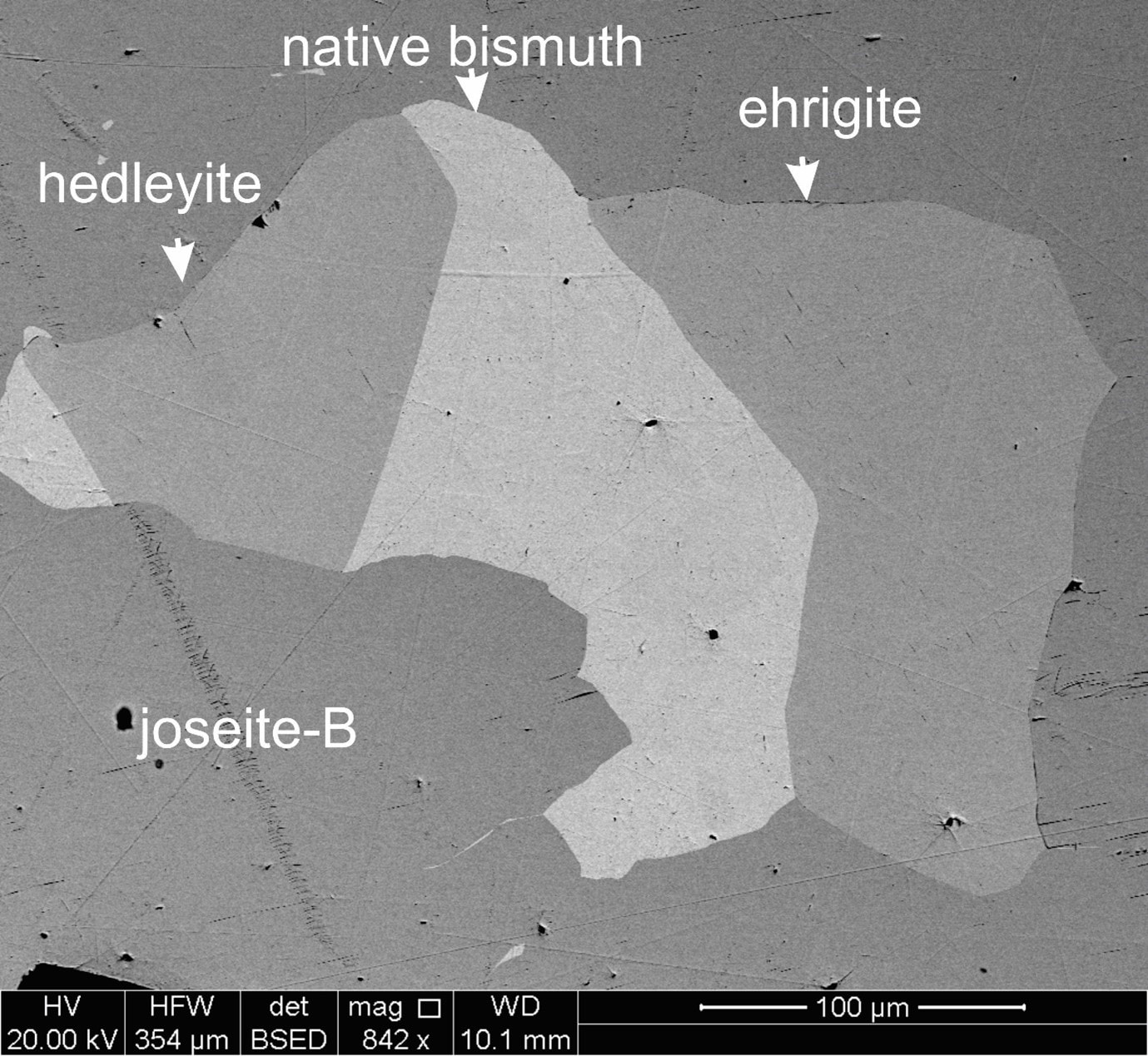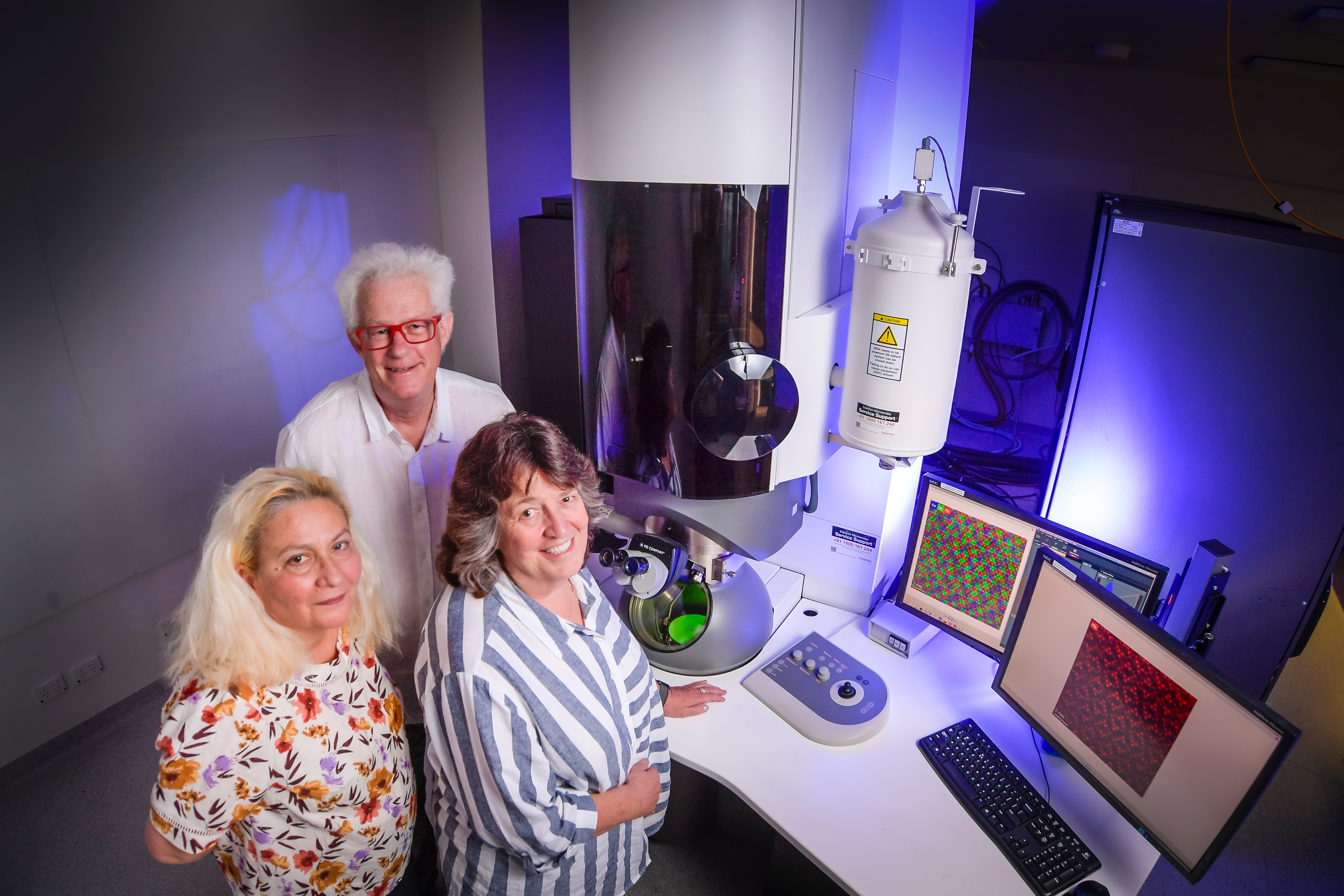04 April 2025
| 8 minute read |
Summary
|
Ehrigite, a new mineral named after Dr. Kathy Ehrig, has officially been recognised by the International Mineralogical Association. |
|
|
The discovery has helped to bridge the gap between geology and processing and has proved pivotal to increasing our knowledge of mineral deposits and production processes. |
|
|
The collaboration between academia and industry has driven advancements in understanding mineral formation and the use of advanced techniques like atomic-resolution transmission microscopy. |
It’s not every day you find a new mineral but two scientists at the University of Adelaide have found a very small, new compound and named it after BHP’s Superintendent Geometallurgy Dr Kathy Ehrig, in recognition of her many contributions to the fields of geology and geometallurgy.
ln a groundbreaking achievement, the new mineral, named Ehrigite (pronounced air-rig-ite), has been officially recognised by the International Mineralogical Association (IMA) Commission on New Minerals and Mineral Nomenclature.

Image 1: Ehrigite as seen under the atomic-resolution transmission microscope
Ehrigite is a sub-microscopic bismuth telluride mineral. It has a unique crystal structure which required the use of the world-class atomic-resolution transmission microscope (at the University of Adelaide) to identify a previously unrecognised mineral.
Associate Professor Cristiana Ciobanu and Professor Nigel Cook, scientists from the University, discovered the mineral and chose to name it after Kathy in recognition of her contributions to the fields of geology and geometallurgy.

Image 2: From Left to Right – Associate Professor Cristiana Ciobanu, Professor Nigel Cook and Dr Kathy Ehrig.
Their efforts to have Ehrigite accepted as a new mineral spanned more than a decade, and the unanimous acceptance of Ehrigite by international colleagues is testament to Kathy's recognition in this area of research.
“I’m a scientist who happens to work in the mining industry” - Dr Kathy Ehrig.
For over three decades, Kathy has been striving to understand how to discover more high-grade ore and characterising deposits for geometallurgy, improving the communication between the ore and the plant.
Her dedication to understanding mineral deposits and improving geometallurgy has paved the way for numerous advancements in the industry.
One such contribution is her ability to bridge the gap between geology and minerals processing. By characterising the mineralogy and processing properties (i.e. the discipline of geometallurgy) of our deposits well in advance of mining and processing, the Olympic Dam Geometallurgy team and Kathy improved the communication between the ore and the plant, leading to reliable predictors of future processing performance.
This interdisciplinary approach enhanced understanding of mineral deposits and optimised the production process, reducing waste and increasing metal recoveries which helps to improve efficiency, reduce costs and achieve more sustainable growth.
Kathy says that her advances are not hers alone, but a team effort and would not have been possible without the ongoing support of the Olympic Dam Geometallurgy team.
Broadening the body of geometallurgical knowledge
Kathy's collaboration with academia has also been instrumental in advancing the field of geometallurgy. Her long-standing partnership with the University of Adelaide has resulted in numerous discoveries, including the identification of Ehrigite.
This collaboration has utilised state-of-the-art analytical techniques, such as atomic-resolution transmission microscopy, which have revolutionised the understanding of mineral formation.
In addition to her scientific contributions, Kathy has been a mentor and role model for young scientists and researchers. Her advice to aspiring geologists:
“If you do not love what you are doing, get out of the business. If you are not going to give up a lot, it is not for you. Love what you do to get you through the swings – those ups and downs.
Discovering a new mineral
Each year, only 90 to 110 new mineral species are officially approved. There are only 6,100 minerals officially recognised by the IMA, with new mineral names often derived from where the mineral was found or based on its composition.
The application for a new mineral species and name undergoes a rigorous procedure of vetting from experts in over a dozen countries to ensure that the mineral has a distinct chemical composition and crystal structure.
The significance of discovering new minerals
Like Ehrigite, most new minerals being discovered today are microscopic and require both skilled researchers and high-resolution instrumentation.The discovery of new minerals can lead to advancements in technology and industry. For example, rare earth elements are crucial for the manufacturing of electronics, renewable energy technologies, and even defence systems. Discovering new minerals can provide alternative sources for these essential elements, reducing dependency on existing, often limited, supplies.
Mining and processing new minerals can also create jobs and stimulate economic growth in regions where these minerals are found, opening new markets and industries that further drive economic development.
The discovery of new minerals enhances scientific knowledge and understanding of the Earth's processes. Each new mineral discovered provides insights into the geological history and ever-changing conditions of the Earth, which can be invaluable for researchers studying the planet's formation, evolution, and the various natural processes that occur within it.
The discovery of Ehrigite emphasises the advances in understanding how minerals form, achieved through analytical resolution down to the atomic scale. This knowledge helps us find minerals more effectively, determining where they are likely to form and where deposits can be found, and more importantly, how we might extract more value from our existing deposits.
This knowledge helps us hunt for minerals more effectively, determining where they are likely to form and where deposits can be found. The extraction process will depend on how the mineral is created in nature, leading to more targeted and efficient methods.
The discovery of Ehrigite is just the beginning.
As work continues on exploring the complexities of mineral formation and properties, new insights are expected to be uncovered, as well as the development of innovative techniques that will shape the future of geometallurgy.
The recent $894,000 Australian Research Council grant awarded to Nigel Cook and Kathy to further develop applications of computational mineralogy to copper-iron sulphides is a testament to the potential of this field.
This research will have significant implications for resources like those at Olympic Dam, one of the world's largest ore bodies.
The recognition of Ehrigite as a new mineral is a fitting tribute to Kathy's exceptional contributions to geology. This discovery celebrates her legacy, underscores the importance of continuous research and collaboration in advancing our understanding of mineral formation and properties, and serves as a reminder of the incredible potential of geometallurgy.
By fostering innovation and collaboration, BHP is committed to driving sustainable growth and responsible resource management.
For more information, please visit:
Get the latest BHP news alerts, straight to your inbox
Get BHP news first. Stay in touch with our latest updates, investor news and media releases.



